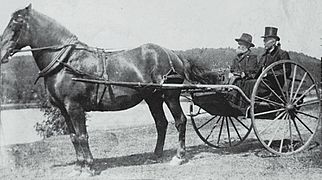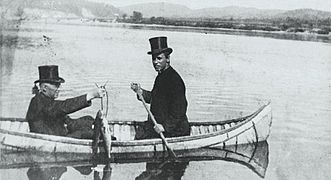Rivière aux Rats (La Tuque) facts for kids
Quick facts for kids Rivière aux Rats |
|
|---|---|
| Country | |
| Province | |
| Region | Mauricie |
| Physical characteristics | |
| River mouth | Saint-Maurice River La Tuque (urban agglomeration) 47°13′12″N 72°53′26″W / 47.22000°N 72.89056°W |
| Length | 60 km (37 mi) |
The Rivière aux Rats is a river in Quebec, Canada. Its name means "Rat River" in English. It flows for about 60 kilometers (37 miles) through forests in the La Tuque (urban agglomeration) area, which is part of Mauricie. The river ends by flowing into the Saint-Maurice River. This meeting point is near a small village also called “Rivière-aux-Rats”. It's about 29.5 kilometers (18 miles) south of downtown La Tuque along Route 155.
Where the River Flows
The Rivière aux Rats is a branch of the Saint-Maurice River. It joins the Saint-Maurice River from the west side. Its mouth is about 500 meters upstream from the "Rivière-aux-rats" road bridge. It is also one kilometer upstream from where the Wessonneau River flows into the Saint-Maurice. Most of the Rivière aux Rats flows through an area called the Zec Wessonneau.
The river starts near the Vermillon River. Its source includes water from lakes like Nathalie, Blazer, and “Lac aux rats” (Rat Lake). As it flows, the river gets more water from the “Petite rivière aux rats” (Little Rats River). This smaller river brings water from lakes such as Pierre-Antoine, “Petit Lac aux Rats,” and Moose Lake. From this point, the river often twists and turns. It first goes south, then turns southeast. A forest road follows the river, sometimes on its south side, sometimes on its west side. Other lakes, like Cinconcine and Dumoulin, also feed into the Rivière aux Rats from the north.
A Look Back in Time
The Rivière aux Rats has a long and interesting history. From the 1600s, it was an important route for trading furs. The Hudson's Bay Company even set up a trading post at the river's mouth. This post was used until the mid-1800s. It helped people trade furs between the Saint-Maurice and Vermillon River areas.
In 1806, a traveling merchant named Jean-Baptiste Perrault wrote about the "Fort of the Rivière aux rats." Later, in 1823-1824, Francis Verreault mentioned a "station established at a place called Utsasht-ushipi (Rivière aux rats)."
Around the mid-1800s, people started getting rights to cut timber in public forests. This led to many logging projects near the Rivière aux Rats.
In 1887, John Baptist, who owned many forest areas, created a large farm at the river's mouth. This farm helped supply the logging camps with food and other goods. During this time, the village of "Rivière-aux-Rats" grew on the east side of the Saint-Maurice River, across from Baptist's farm. Other small villages also grew along the Saint-Maurice River's east bank because of a road connecting Grand-Mère to La Tuque.
In the 19th century, Catholic church services for the Middle and Upper Mauricie regions were often provided by priests from Saint-Tite. Forest workers and contractors could also buy supplies from traders in towns like Saint-Tite, Saint-Stanislas, Saint-Narcisse, and Sainte-Geneviève-de-Batiscan.
In 1910, a Catholic mission was started in "Rivière-aux-Rats." It was named "Saint-Jean-Baptiste" (St. John the Baptist). This name honored both French Canadians and the oldest resident of the area, Jean-Baptiste Hennesse.
Logging camps near the Rivière aux Rats continued to operate until 1984. A ferry used to connect the two sides of the Saint-Maurice River until 1980, when a bridge was built.
There's a place on the Rivière aux Rats called the "Jetée déboulante Dickey" (Dickey Tumble Down Pier). It was named after Jimmie Dickey, who was a foreman at the logging sites. The name "Dickey" is also used for "Dickey's Cove" and "Dickey's Lake." This pier was a place where loggers would push logs down a mountain.
What's in a Name?
The name “Rats” in "Rivière aux Rats" refers to muskrats. There used to be many muskrats in the Mauricie region. In the 1800s, some Canadian surveys even counted how many muskrats each family caught! The Abenaki people, who are Indigenous to the area, called the river “Moskwastekw,” which also means "River muskrats." Over time, the French name became the most common.
The name “Rivière aux Rats” was officially recorded on December 5, 1968, by the Commission de toponymie du Québec (Geographical Names Board of Québec).




